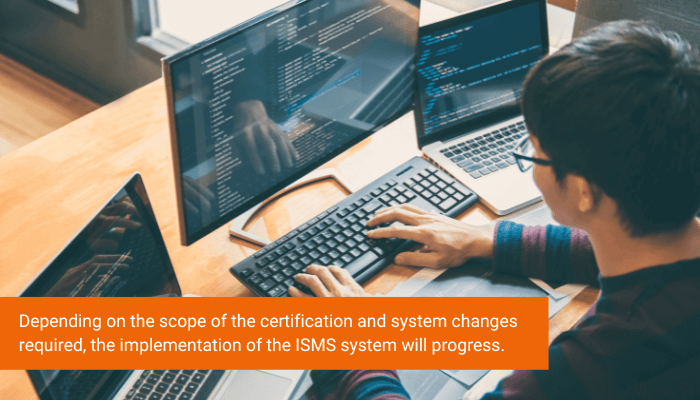Implementing Information Security Management System (ISMS) is essential for all types of organizations. All organizations irrespective of size have a vulnerability to cyber-attacks.
The ISMS Standard is focused on protecting the confidentiality, integrity, and Availability (CIA) of information. Implementing the standard will have significant benefits for the company.
Many organizations fail to implement appropriate measures to protect their IT systems from data hacks. A robust Information Security Management System is the solution to eliminate the risk of data attacks.
However, there are numerous challenges faced by the Information Technology team when it comes to implementing the Information Security Management System in an organization.
Challenges of Implementing Information Security Management System
A few of the common challenges reported by the employees working in the field of IT Security are there is a lack of awareness about cybersecurity best practices in their organizations. Similarly, many of them face challenges in creating and managing the Information Security Management System.

Information Security Risk Assessment and understanding the requirements of the ISO 27001 Standard is quite complex. There are numerous challenges when it comes to implementing an Information Security Management System.
1. Not Identifying Most Critical Data
Depending on the size of the organization, it becomes quite challenging to identify the most critical data points. It requires immense effort to analyze and segregate the available data in an organization.
Also, assigning responsibility to teams and ensuring the data is not mishandled is a daunting task for most organizations.
Hence, the team must identify the right location of the data, determine how to build control points, and eliminate the risk of data loss.
2. No Policies in Place for Sensitive Data Protection
In many organizations, there are no specific policies for handling sensitive information among employees.
There are many instances where the company’s information is getting compromised as the employees are accessing files across a common system. To curb that data loss, there must be robust policies that highlight certain aspects of usage with restrictions.
For example:
- Using public Wi-Fi for work purposes
- Employees with high-level access viewing sensitive information in their home offices
- Limits in downloading certain file types and sizes.
- Limiting geographical access to files in the common system and more
3. Lack of Employee Awareness in Company Policies
For the success of the Information Security Management System in an organization, the employees at all levels must be aware of the cybersecurity best practices.
Proper awareness training on Cybersecurity Standards is essential for organizations to effectively implement the ISO 27001 certification.
4. Technology Implementation Delays
For securing the organizational workplace from cyber attacks, new technology for server protection and antivirus software for devices, and other technology advancements are required.
In most organizations, technology adoption is delayed due to management review meetings, lack of funds, etc.
5. Limiting Vendors Accessing Sensitive Information
In many instances, limiting vendors from accessing sensitive information is quite challenging due to the nature of the business activity. However, to effectively secure the information security systems it is essential to limit vendors from accessing all company information.

The IT team must work out a way to share the required information for them to do their work. Putting the right control points will lead to mitigating the risks of potential data hacks.
The process to Mitigate the challenges faced in obtaining ISO 27001 Certification
To mitigate the challenges faced in obtaining ISO 27001 Standard, a well-structured process is to be followed by the organization. Depending on the scope of the certification and system changes required, the implementation of the ISMS system will progress.
1. Periodic Risk Assessment
Conducting a periodic risk assessment is a best practice to identify system vulnerabilities. The periodic risk assessment helps companies to know their challenges while implementing the ISO 27001 certification.
The ISMS Certification has a solid information security policy and a risk assessment methodology. The risk assessment will help in identifying the areas of attention and scoring the risk. Thereby, applying the correct actions accordingly.
2. Project Ownership
The Cybersecurity project in an organization is not only the responsibility of the IT but all the employees. Support across the departments is required for the success of the Cybersecurity implementation in an organization.
All the officials in the key departments must collaborate with the IT team. It will help in identifying all the critical information areas in the organization. Also, help the functional teams to take corrective actions and share the project ownership.
3. Efficient Project Planning
The ISO Consultants must efficiently plan the IT Security Implementation projects. Depending on the business operations, functional departments, and employee size, the scope of the implementation project will vary.
Proper project planning helps an organization implement a full-fledged information security management system.
Through efficient project planning for ISO 27001 Certification implementation, the risk of cyber attacks can be mitigated.
4. Business Investment
Business investment in the new process, technology, employee training, software application, etc., will help the organization in securing its internal systems from data leaks.
The top management must be open to investment in IT Security to ensure that sensitive company information is not at the risk.
5. Gap Analysis and communication
Conducting Gap Analysis is an important aspect of mitigating the risk of cyber attacks. The business operations across the organization are audited and all vulnerabilities are listed.

It will be communicated effectively to the top management by conducting a management review meeting. Thus, all teams and top management will have clarity on the business operations and the scope of implementing the cybersecurity best practices.
Hence, in conclusion, implementing the best practices of cyber security and getting an ISO 27001:2013 certification helps in eliminating the risks of any data attacks.
Organizations are facing higher risks of cyberattacks due to extensive internet usage, access to public wi-fi systems by employees, vendor access vulnerabilities, and many more reasons.
So getting the ISO Cyber Security Certification for your organization is very essential to keep the internet IT system and business process secure from any data hacking efforts.
To know more about the ISO 27001:2013 Certification and cybersecurity best practices, connect with our expert ISO team right away!
Contact Us: Aurion ISO Consultants



